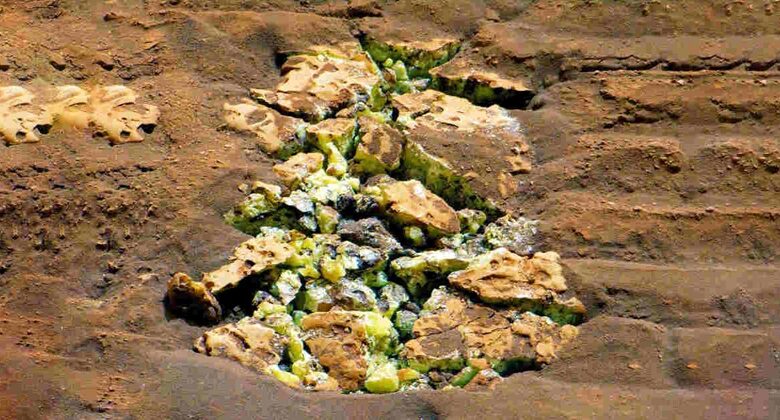NASA’s Curiosity Rover Unveils Groundbreaking Discovery Of Sulfur Crystals on Mars

News Mania Desk/Agnibeena Ghosh/21st July 2024
NASA’s Curiosity rover has made a groundbreaking discovery on Mars, uncovering rocks composed of mysterious sulfur crystals, a first for the Red Planet. On May 30, 2024, the rover inadvertently cracked open a rock, revealing vibrant yellow sulfur crystals that had never been observed on Mars before.
Since October 2023, Curiosity has been exploring a sulfate-rich region of Mars. While sulfates have been previously detected, they were always found as part of sulfur-based minerals. This recent discovery marks the first time elemental, or pure, sulfur has been identified on the planet. Ashwin Vasavada, Curiosity’s project scientist at NASA’s Jet Propulsion Laboratory, likened the discovery to “finding an oasis in the desert,” emphasizing its unexpected nature and the need for further explanation.
The sulfur crystals were found in the Gediz Vallis channel, an area of significant geological interest on Mount Sharp. Scientists believe this channel was formed by ancient water flows and debris, providing valuable insights into Mars’ past environmental conditions. This discovery has important implications for understanding Mars’ geological history and potential for supporting life. While sulfur itself is not direct evidence of life, its presence can offer clues about past environmental conditions that might have been conducive to microbial life.
The Curiosity rover has been exploring Mount Sharp for over seven years, studying its layers to understand when and where Mars might have had conditions suitable for microbial life. The recent findings in the Gediz Vallis channel suggest a complex history involving both water flows and landslides. On June 18, Curiosity drilled its 41st hole in a nearby rock nicknamed “Mammoth Lakes.” The powderized samples collected are being analyzed to determine their composition, potentially offering more insights into Mars’ puzzling geological past.
The discovery of these sulfur crystals is significant not only for its novelty but also for what it could reveal about Mars’ ancient environment. Elemental sulfur is something scientists have never seen on Mars before. Its existence in such a pure form hints at unique geochemical processes that could have taken place on the planet, possibly involving volcanic activity or water-rock interactions under specific conditions.
Mars’ sulfate-rich regions have been of particular interest because they can form in water, suggesting that these areas might have once had liquid water. The presence of pure sulfur crystals adds another layer of intrigue, indicating that the Red Planet’s history is more complex than previously thought. This discovery could help scientists piece together the environmental conditions that existed on Mars billions of years ago, potentially revealing habitats that could have supported microbial life.
As Curiosity continues its mission, each new discovery brings scientists closer to understanding Mars’ enigmatic past. The rover’s ongoing exploration of Mount Sharp is crucial for unraveling the geological and climatic history of the planet. By studying the rock layers and compositions, scientists aim to answer the fundamental question of whether Mars ever had the conditions necessary to support life. It opens new avenues for research into the planet’s geochemical processes and environmental history. As Curiosity continues to explore, the findings from its mission will undoubtedly deepen our understanding of Mars and its potential to have harbored life in the distant past.






